It isn’t often that I’m able to keep a raptor in frame and in focus for this many shots during and after takeoff.
1/2500, f/6.3, ISO 500, Canon 7D Mark II, Canon EF 500mm f/4L IS II USM + EF 1.4 III Extender, not baited, set up or called in
I found this adult Red-tailed Hawk perched on sagebrush three days ago in northern Utah. The bird was one of a mated pair and I’m unsure of the sex of this one but for the sake of convenience I’ll refer to it as male.
He was perched here for some time but he was largely buried in the sagebrush so I hoped to get lucky with takeoff shots. Sharp eyes will notice the flying insect at upper left.
1/2500, f/6.3, ISO 500, Canon 7D Mark II, Canon EF 500mm f/4L IS II USM + EF 1.4 III Extender, not baited, set up or called in
When resting raptors rouse (shake their feathers to rearrange them) it’s often a sign of imminent launch so when he did just that I tried to guess which way he’d go as an aid to help me keep him in the frame. My best guess was that he would take off to his left and all I would get would be butt shots but trying to out-guess a bird is far from an exact science so I tried to be prepared for anything.
1/3200, f/6.3, ISO 500, Canon 7D Mark II, Canon EF 500mm f/4L IS II USM + EF 1.4 III Extender, not baited, set up or called in
But when he started to raise his wings he also twisted his body toward me in the same motion.
1/2000, f/6.3, ISO 500, Canon 7D Mark II, Canon EF 500mm f/4L IS II USM + EF 1.4 III Extender, not baited, set up or called in
I always enjoy getting their wings in a mostly vertical position like this.
1/1600, f/6.3, ISO 500, Canon 7D Mark II, Canon EF 500mm f/4L IS II USM + EF 1.4 III Extender, not baited, set up or called in
In the actual lift-off shot I like the way the bird fills the frame diagonally.
1/2000, f/6.3, ISO 500, Canon 7D Mark II, Canon EF 500mm f/4L IS II USM + EF 1.4 III Extender, not baited, set up or called in
I was lucky that the hawk kept its focus in the same direction during the entire series which allowed me to get a catch light in every shot.
1/2000, f/6.3, ISO 500, Canon 7D Mark II, Canon EF 500mm f/4L IS II USM + EF 1.4 III Extender, not baited, set up or called in
The force of the takeoff caused small bits of sage debris to fly through the air at lower left.
I damn near clipped a wing on this one…
1/2500, f/6.3, ISO 500, Canon 7D Mark II, Canon EF 500mm f/4L IS II USM + EF 1.4 III Extender, not baited, set up or called in
and the next one. It doesn’t get much closer than that.
1/2500, f/6.3, ISO 500, Canon 7D Mark II, Canon EF 500mm f/4L IS II USM + EF 1.4 III Extender, not baited, set up or called in
Love those dangling feet.
1/2000, f/6.3, ISO 500, Canon 7D Mark II, Canon EF 500mm f/4L IS II USM + EF 1.4 III Extender, not baited, set up or called in
By this time he was getting close enough that I was lucky not to clip anything with his wings in a horizontal position.
1/1250, f/6.3, ISO 500, Canon 7D Mark II, Canon EF 500mm f/4L IS II USM + EF 1.4 III Extender, not baited, set up or called in
In this final image I was slightly surprised that the wings weren’t sharper even though my shutter speed had dropped from 1/2000 to 1/1250 second. At least the head and body are sharp. After this shot I started to lose focus on the bird and clip body parts so those photos will be deleted.
In my experience it’s fairly unusual (though certainly not unheard of) for a hawk to fly almost directly toward the photographer after liftoff. The fact that he did made it a little easier to keep him in frame and since he never dropped below the tops of the sagebrush it was also easier to keep him in focus. If there had been sage directly behind the bird my active focus points might very easily have locked onto it instead.
I’ll take luck whenever I can get it.
Ron


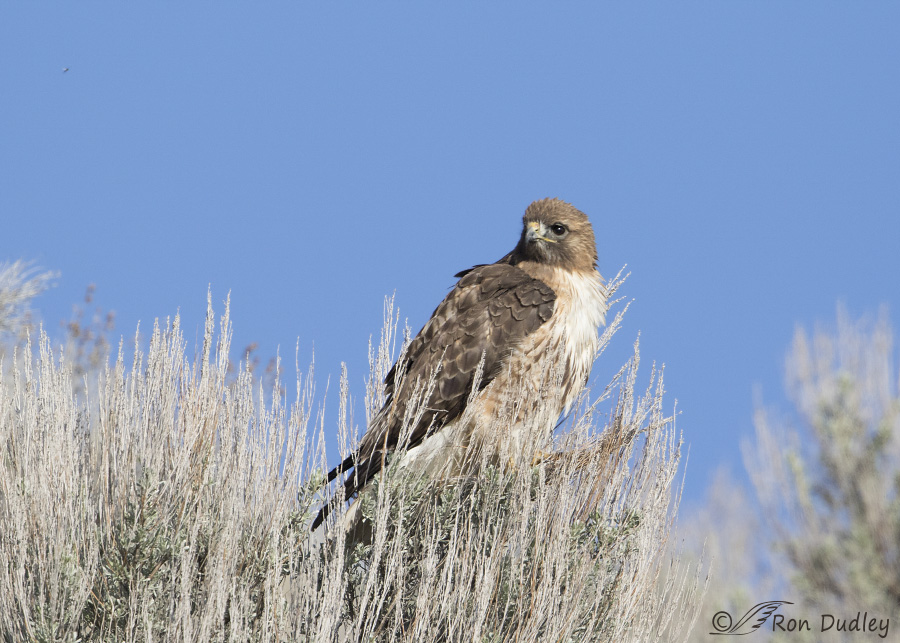
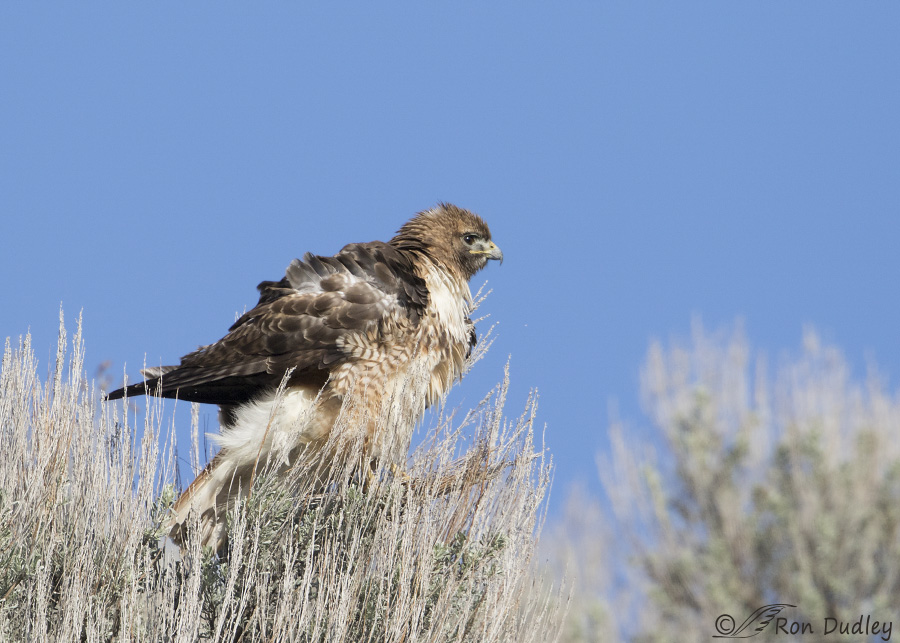
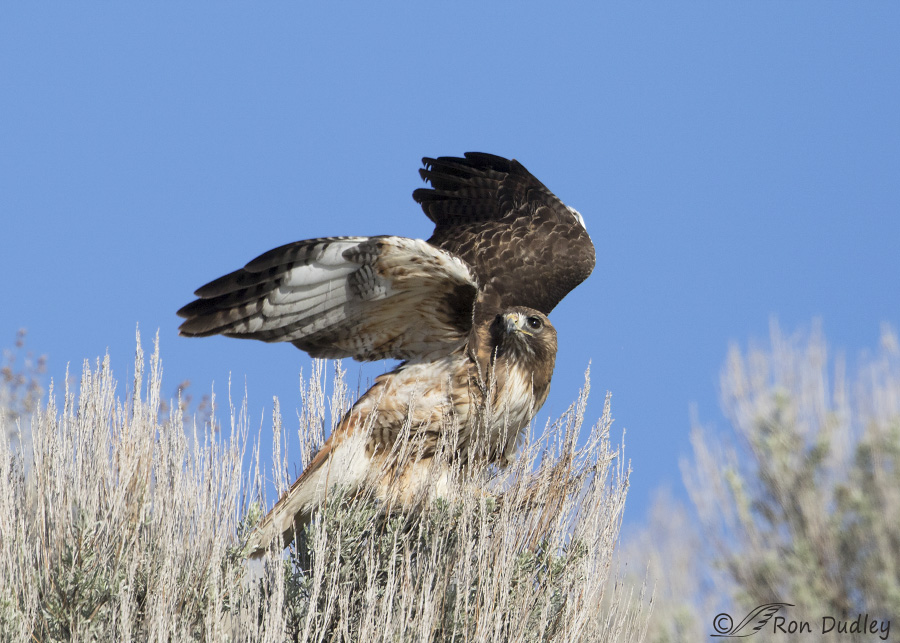
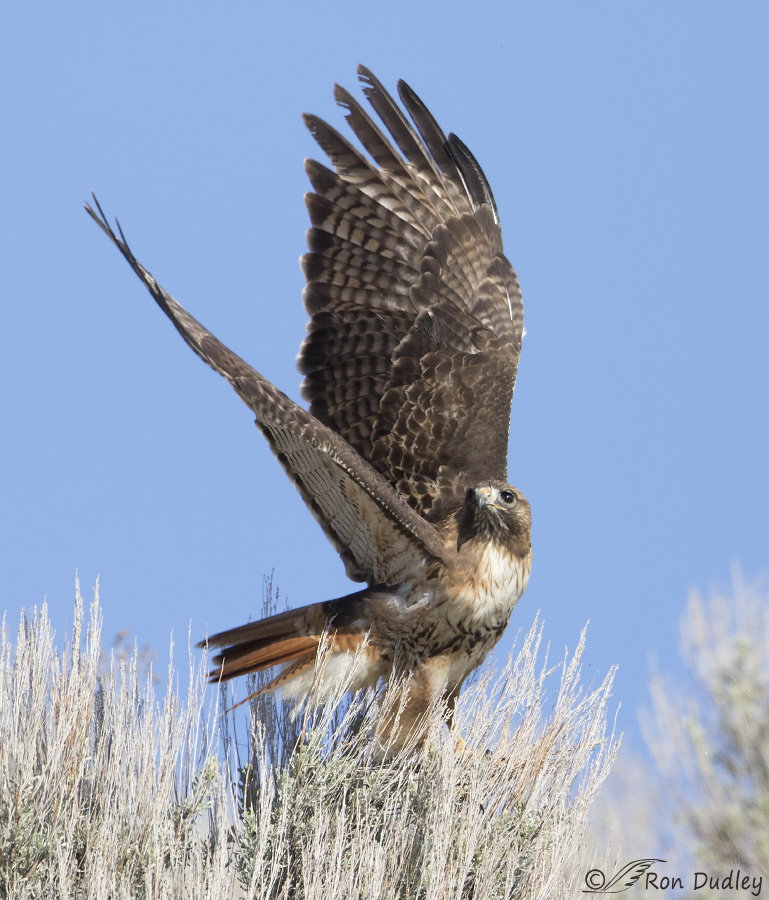
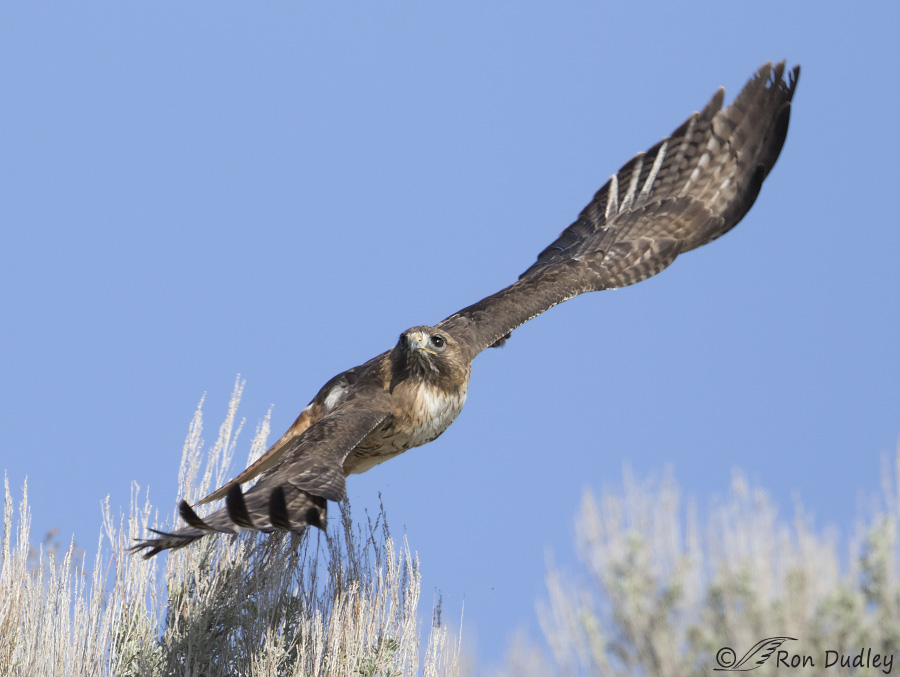
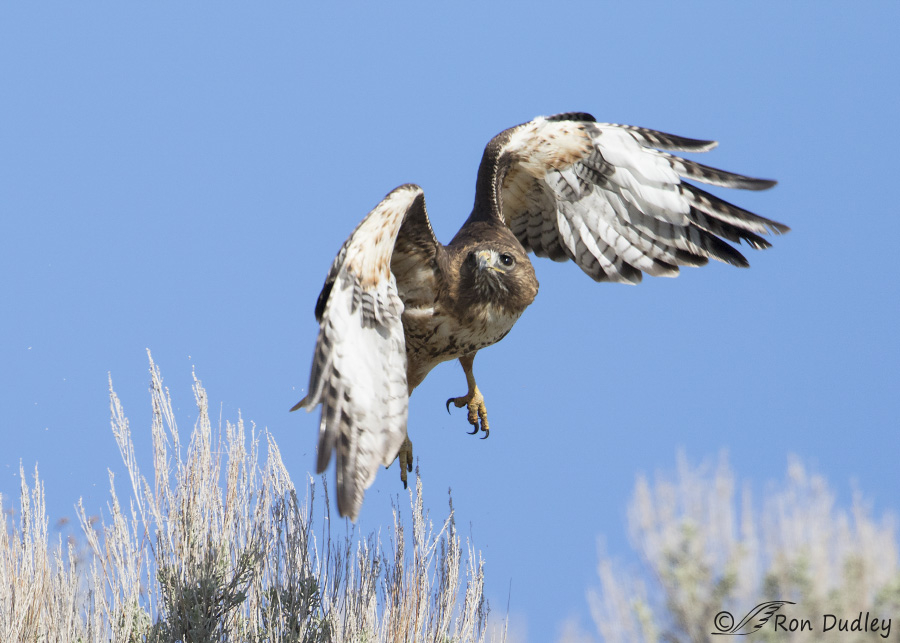
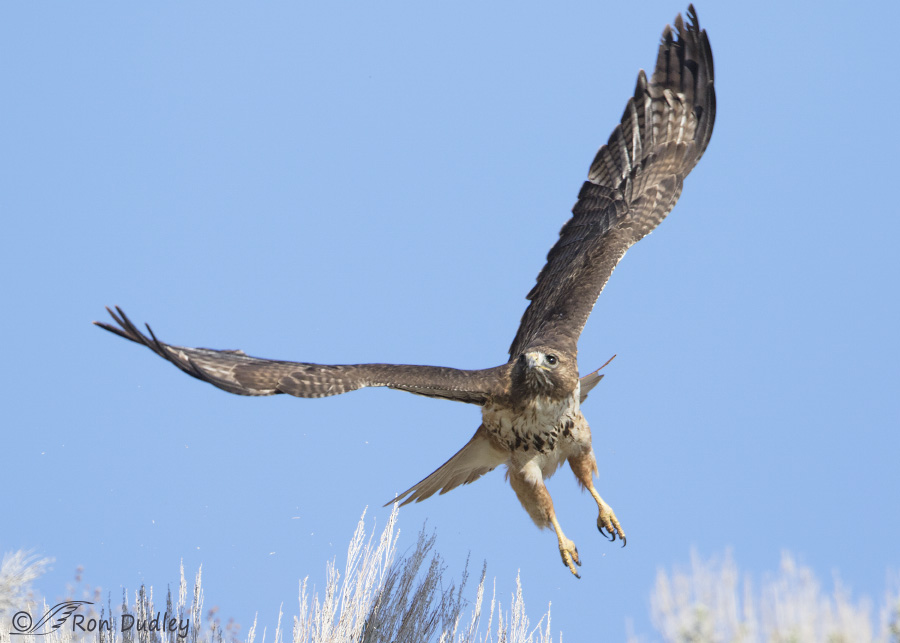
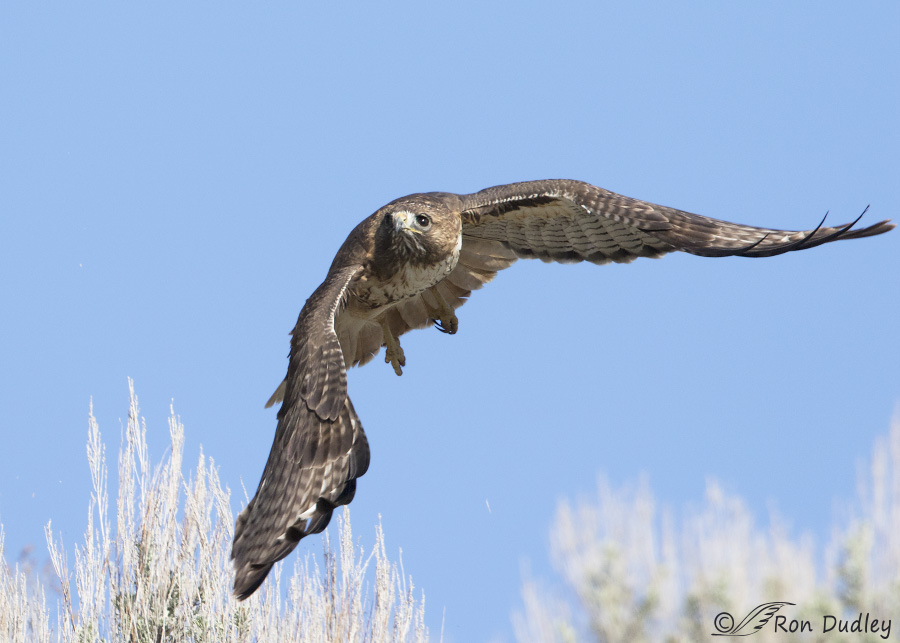
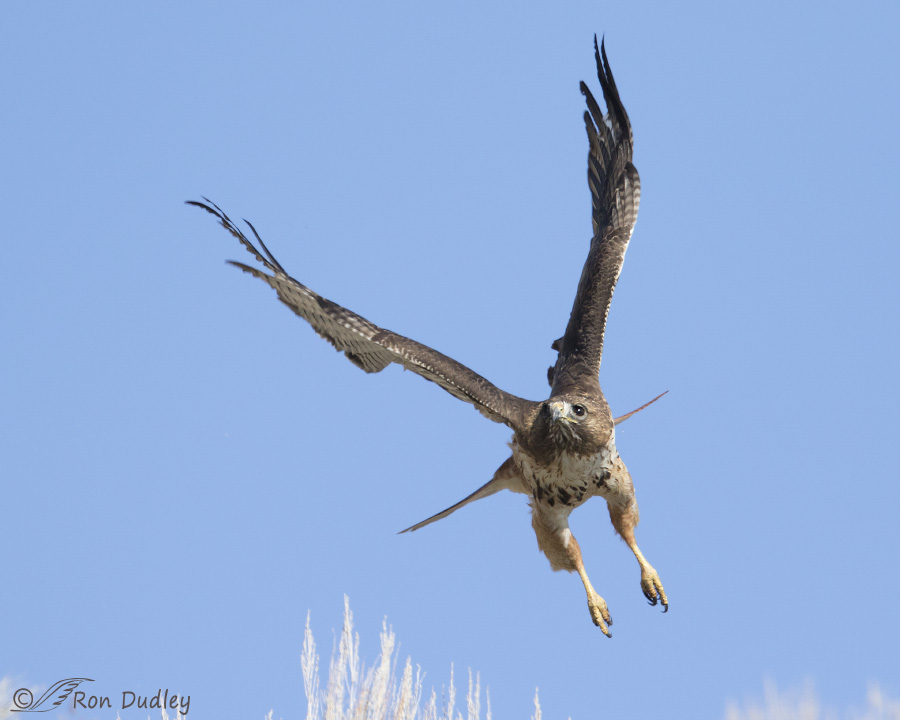
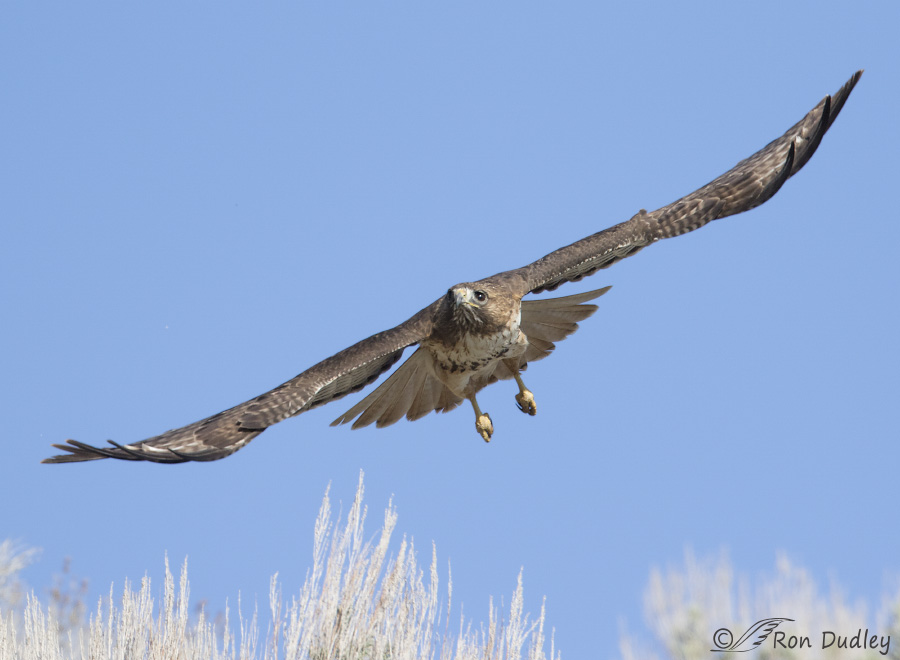
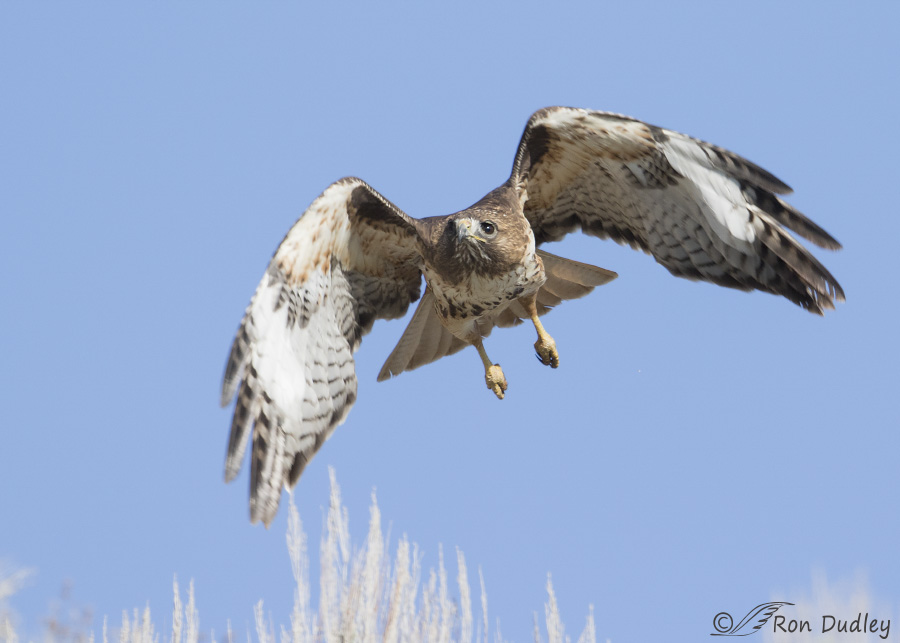
Beautiful Ron, I love the last one. I refer to that as “The Flying M”…its what I see when my Hawks are approaching the glove at a fast speed! It includes the dangling feet too…almost makes them look as if they are on a chair lift….hard to explain, but it is my favorite moment of flight.
Tim
Ron,
Really nice. Luck is nice but you are clearly lucky AND good.
Stephen Clayson
Love these shots, Ron! Almost like being there. Thank you for your passion, talent and willingness to share.
Beautiful. I like 4 and 8 most. I too like the upstroke before the push off. In the the eighth photo I like the twisting of the wings vs the body yet the head stays stable in it’s plane. Such lovely power in those strokes.
Fantastic series of shots Ron. Love em all. The first three shots were in landscape mode whereas the fourth shot is in portrait. So, did you actually rotate the camera to avoid clipping the upright wings, and then quickly go back to landscape? What a maneuver that would be with all the action headed your way. It looks like if you stayed in landscape and cropped the shot to a portrait image the wings would be clipped. The bird made your day and you certainly made mine.
Good to “see” you again, Sterling!
No, that shot (like all the others) was taken horizontally. It’s just that with the wings in a vertical position I thought the composition looked best cropped that way.
Spectacular! They kept getting better…4, then 5, then 7 & 8….Wow! I have many red tails where I live, but never see them in such spectacular moves. You are a master!
Thanks for the fine compliment, LS. This hawk made me look good!
Great series!
Believe me, I have sharp eyes, but I’m not so observant when it comes to photos. Funny how my eyes are better for spotting a bird a mile away than a bug a foot away (when it’s in a photo)!
Levi
And I have poor eyesight, Levi – even squint to read small print with reading glasses. And spotting a bird for away is often impossible for me when others can see it with no problem. Thanks.
Truly amazing. Sublime. And rather a lot of other superlatives.
Thank you. I suspect you were smiling wide enough to make your face hurt as you captured and processed this series. Just looking at them on screen my smile is broad.
I was sure smiling when I saw them on my screen at home, EC. Before that I really didn’t know what I had – you never do. Thank you.
Wow! This has to be one of your best series since I began following you! They’re all wonderful but my favorites are #4 and 5. Did you do any image cropping?
Yes, Ron – all images have been cropped. Thank you.
Ron, you really got a good series here. Hard to pick a favorite. I’d say the lift off shot with the wings diagonal on the screen. They are all keepers!!
Thank you, Zaphir.
WOW! Yet another spectacular series AND of a redtail. I suspect that’s a male, too from the size of the tarsus/feet. And be still my heart! Sigh…such BEAUTY!
Sorry, my hands aren’t working well, so this has to be brief, but THANK YOU!
I’m glad you enjoyed them, Laura. Thanks.
Oh my! They’re all spectacular, Ron. Love the intensity and sense of purposefulness in his eyes and power in those beautiful wings — what an amazing creature. I’d love to see #4 or #7 hanging over my fireplace! Thank you so much for a terrific series, Ron … and for continuing to share your world with us.
Chris, you’re right about his eyes. I don’t think he took them off the same spot (whatever it was) throughout the entire sequence. He was concentrated!
Luck be a lady—and, boy,was she ever!!! BEAUTIFUL SERIES!!!!
Thank you, Patty.
I like all the shots but especially the 5th shot where it shows the curve on the outside of the right wing feathers. It was hard to pick a favorite. Thank you for the beautiful photos.
Thank you, Alice.
Wow. Just. Wow. The 4th shot is so dramatic; they’re all fantastic! And those wings are so close to the edge on 7 and 8 — you say luck; I say skill — still, time to buy a lotto ticket!
How do you manage to top yourself day after day?
“How do you manage to top yourself day after day?”
I usually run in streaks, Marty. It’ll probably be all down hill from here for a while…
As they say, “pics or it didn’t happen.” You may have to post some klunkers.
Great series Ron. Just can’t decide which one I like the best. Nice that the bird took off toward you and again, I am really impressed that you are able to keep the bird in the frame at an effective focal length of 1120 mm. Sure there might be some luck involved, but Great talent pays off. Nicely done.
Exactly, both luck and at least some skill are integral components of good bird photography. Thank you, Frank.
Sweet Series of images with a high degree of difficulty to keep the bird in the frame and keep the focus sensor on the bird!! Nicely done. Great series.
Thanks, Keith. I know that you “get it” so I appreciate what you said.
Great series. The mechanics of flight are amazing! Wonder if it is even possible to do lift or drag calculation on some of those wing positions. Do you know by chance if this is something birds learn or is it instinct? Thanks again for sharing, Bill
Bill, I don’t know the answer to your question but it would be my guess that it’s a combination of both.
WOW! AWESOME SERIES RON!!!
Charlotte
Thanks, Charlotte.
WOW, WOW, WOW…………
Absolutely fantastic shots. I love the fact you were able to keep the hawk mostly in the diagonal.
I don’t know how you do it with a moving subject and keep the camera and lens steady enough. I am finding that I have to lift my camera up off of its perch on the window more times than not. Guess I’m not as nimble as when I was younger! LOL.
It doesn’t always work out, Dick. If the bird goes higher or lower than I can follow it at the level I have my window and lens support (noodle) I then have to hand-hold and often miss the shots. All we can do is keep practicing at it and eventually we become better but it’s never easy.
You can say that over and over !!
Ron, this is great information on how to stay ahead of the action. I’ve experienced this many times when shooting this bird and in fact one time it flew only inches past me I seriously thought it was going to grab my gear! The feel of the wind as the bird flies past you is exhilarating. In my case i was only less than 20 feet away braced against a pine tree while the bird was on the next tree. My question for you is, do you feel that the ability to zoom out would have been beneficial with this type of scenario? Or is any benefit of convenience less important than the IQ/performance of the prime lens?
Thank you again for sharing your work and expertise.
Elmer, tradeoffs are always a big part of bird photography. Yes, there would have been some advantage to a zoom in this situation but all things considered I prefer the image quality of a prime lens. And when I can I partially (only partially though) substitute for the flexibility of the zoom by carefully choosing my distance from the bird before it takes off (either physically or optically by removing my teleconverter or both).
Positively thrilling ! I’d love to see this series printed and displayed side by side on a wall…….
Wow, that would be a lot of prints, Kris!
Oh-My-God, Ron!! What a stunning series!! It’s hard to pick a favorite but I’m going to go with the 4th photo in your series. There is just something so majestic in his position at that moment. I wish I could have been there to see it in person!!
Yes, that fourth shot is pretty dramatic. Thanks, Jo Ann.
Great series, Ron! No, it seems they generally take off away from the photographer so this is/was special. Always amazing how much wing unfolds when they do take flight.
No, it seems they generally take off away from the photographer so this is/was special. Always amazing how much wing unfolds when they do take flight. 
“Always amazing how much wing unfolds when they do take flight.”
Exactly, Muffy. That’s a big part of the reason why so many wings are clipped by photographers. Thanks.
Fantastic photos, Ron. Thanks so much. Elizabeth
Thank you, Elizabeth.